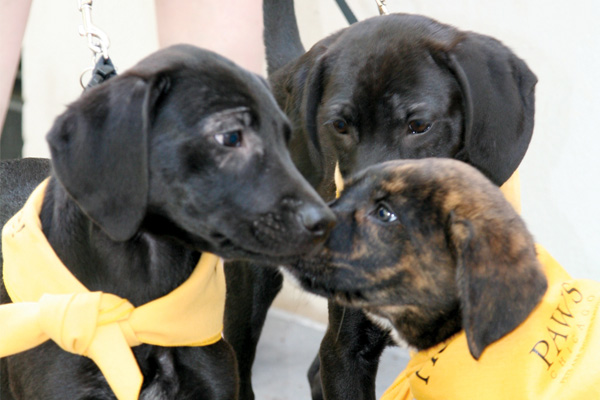Canine Social Systems The Human Role
by Joan Harris | Nov 01, 2010

“A species so intimately involved with our own, which has shared our life since time immemorial.”
- Alfred Barbou
Let’s start at the very beginning of our relationship with dogs. No one knows exactly when dogs were domesticated but the journey is very profound. It is a common theory that our domestic dogs evolved from the wolf. Dogs and wolves belong to the same species Canis lupus as well as the same family Canidae; the DNA code of dogs and wolves has been found to be identical. Most domestic dogs today are believed to be descendants of the grey wolf better known as the timber wolf.
It is believed that wolves may have gathered around the campfires of our Paleolithic ancestors scavenging for scraps of food some 14,000 - 17,000 years ago. Man discovered the wolf’s natural ability to be a team player and invited him to stay. Cohabitation with humans greatly improved the chance for survival for both species and the partnership began.
The dog-human partnership set both species on a new evolutionary course. Dogs were selectively bred to perform tasks that man was unable to do. They became our protectors, herders, hunters, companions and baby-sitters. The strong bond we feel with our dogs led us to treat them like members of our family. It is no wonder that when we choose to live so intimately with our dogs that it is essential to study and comprehend their social systems.
This usually leads us back to studying the pack behavior of wolves, our dog’s ancient ancestors. Our present day dogs share various traits with their ancestors such as body postures and an innate knowledge of pack hierarchy. A wolf pack is a highly disciplined group who work together. The alpha pair has the greatest amount of social freedom among all the pack members. They do not give “orders” to the other wolves but instead have privileges such as eating first, mating and initiating interactions.
The pack usually follows the alpha pair and consists of various subordinates. The omega is the lowest ranking wolf in the pack. In larger packs, there may also be a beta wolf or wolves. They are “second-in-command” to the alphas. The wolf pack functions as a cooperative unit, rather than competing amongst themselves for resources or trying to dominate each other.
Rank order is established and maintained through a series of ritualized fights and posturing. Wolves prefer this to physical confrontations. Physical confrontations would only serve to weaken the pack. Rank order can shift constantly according to the needs of the pack at any given time. Rank order is only one of the many social traits used to keep the pack running smoothly. Wolves possess many ritualized behavior patterns that are recognized amongst other pack members to have a specific meaning.
In her book, “Aggression In Dogs”, Brenda Aloff states that dogs also use ritualized behavior patterns to determine without resorting to violence, who gives in and who prevails in situations where conflict exists. Although developing our skills for understanding a dog’s language is a subject in itself, we need to understand how a dog interacts with members of its own species to understand how he is attempting to interact with us.
By gaining an understanding of the complexities of canine behavior we can bypass the notion that every problem behavior we encounter with our dogs is due to the dog being either “dominant” or “submissive”. Dispelling this notion opened the door for a broader view of how we can relate to our dogs. Dog training that relies solely on the use of physical correction or the notion that a dog needs to be physically dominated is a thing of the past.
The American Veterinary Society of Animal Behavior (AVSAB) warns against the use of “dominance” based training techniques explaining how they can damage the human-dog relationship. The AVSAB goes to great lengths to explain the difference between leadership and dominance stating that, “leadership is established when a pet owner can consistently set clear limits for behavior and effectively communicate the rules by immediately rewarding the correct behavior and preventing access to or removing rewards for undesirable behaviors before the undesirable behavior is reinforced.”
Science based dog training methods, spearheaded by the work of Karen Pryor, are now being explored and widely used. Pryor used psychologist B. F. Skinner’s theory of operant conditioning to develop the clicker training method in which a small plastic noisemaker is used to mark a behavior that will earn a reward. An animal tends to repeat an action that has positive consequences. The results are amazing. Dogs learn with eagerness and gain a clear understanding of the task at hand, unclouded by the fear of making a mistake and physical punishment.
Our relationships with our dogs continue to evolve. In our present day urban environment, dogs no longer perform tasks that are needed for our survival. Still they are an important part of our lives. We depend on them for companionship and unconditional loyalty and affection. They get us out every day for walks and work as our partners in agility class. They still function as playmates for our children and companions for the elderly. It’s a safe bet that man will always have a place in his home for the family dog.
